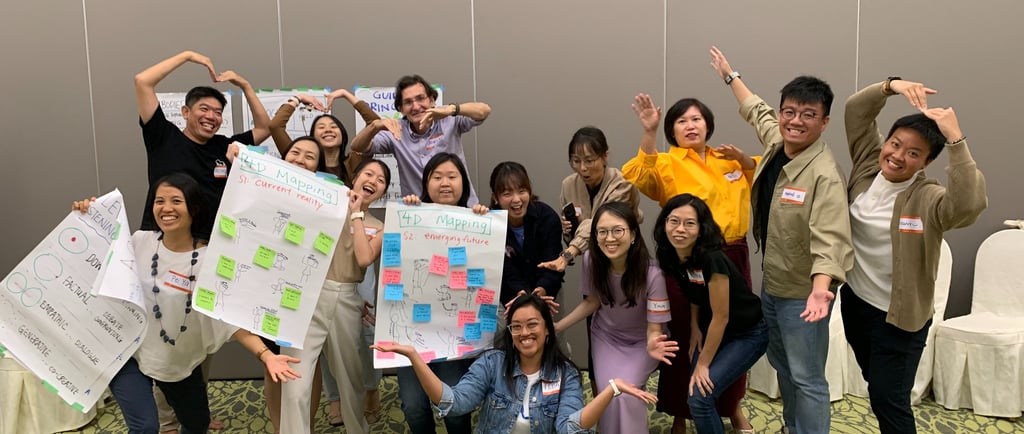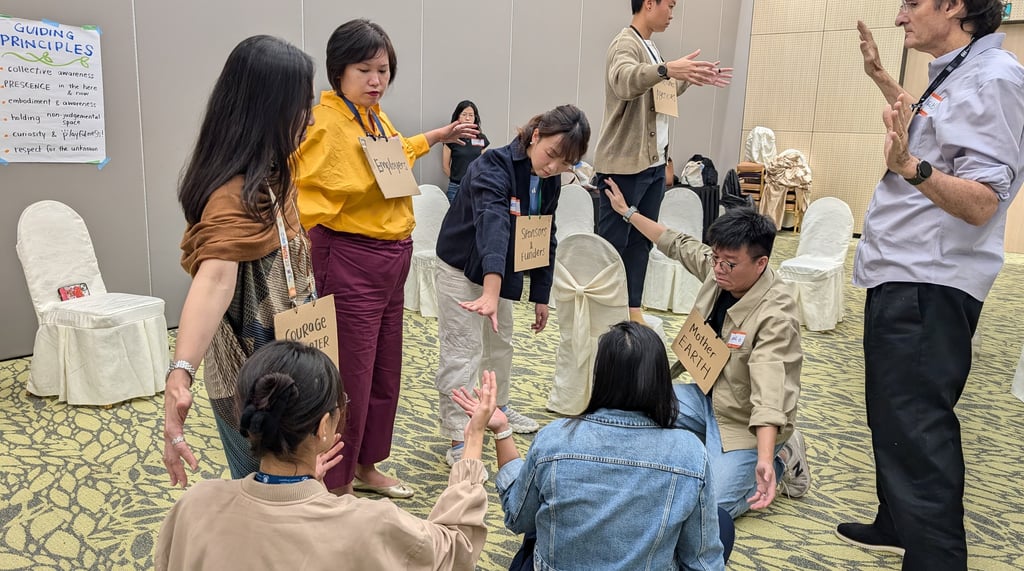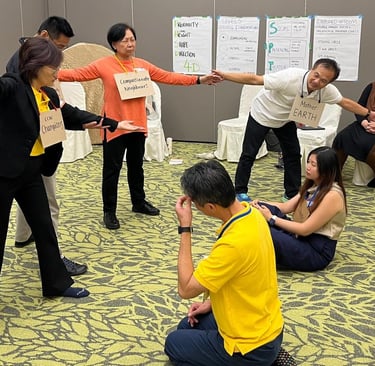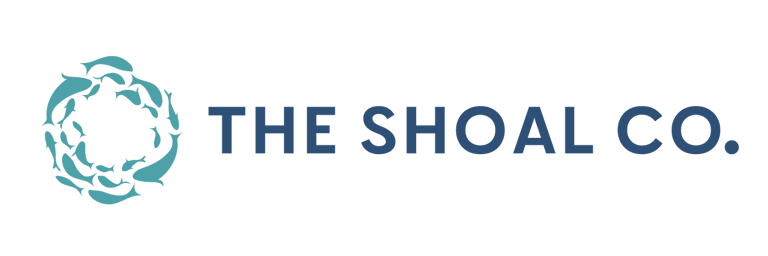When the System Speaks
Insights from Two 4D Mapping Sessions at the International Association of Facilitators Singapore Conference 2025
PAST EVENT
10/16/20255 min read


At the recent IAF Singapore Conference, The Shoal Co. and The Collab Folks facilitated two sessions titled “Embodied Wisdom: Exploring Systems through Social Presencing Theatre (SPT).” We explored two social enterprises:
The Courage Chapter – How might The Courage Chapter build a sustainable model where seniors are valued contributors to work and community?
Centre for Community Wellbeing (CCW) – How might we encourage and empower neighbours to care better?
What is Social Presencing Theatre?
Social Presencing Theatre, developed by Arawana Hayashi and the Presencing Institute, is a set of body-based practices that help groups sense and see systems as living fields. It blends mindfulness, embodiment, and systems thinking to make visible the often-invisible dynamics — power, relationships, hopes, and tensions — that shape collective change.
Instead of discussing problems, participants use their bodies to represent key stakeholders, including archetypes for the system’s marginalized communities, Mother Earth, and its highest future potential (addressing the three respective divides in Theory U: social divide, ecological divide and spiritual divide). Through stillness and simple movement, participants sense what is — and what is ready to shift.
🌿Courage Chapter: From Programs to Changemakers
Courage Chapter is a social enterprise that supports senior professionals in finding meaningful “next chapters.”
Challenge: How might The Courage Chapter build a sustainable model where seniors are valued contributors to work and community?


Photo 2: The Courage Chapter 4D Mapping Sculpture 2 (emerging future)
In the 4D mapping, participants first embodied the current reality of this ecosystem which felt fragmented and hierarchical, with power concentrated upstream:
Government Agency: “I hold control.”
Training Providers: “I can help.” (mostly through courses)
Sponsors / Funders: “I want to help.”
Employers: “I have a limited budget.”
Courage Chapter: “I facilitate the connections.”
Senior Professionals: “I want to do more.”
Mother Earth: “We need to care more.”
Seniors as valued contributors (Highest Future Potential): “I have skills; I can contribute.”
The system was well-intentioned but transactional — focused on short-term programs and participation metrics rather than long-term value creation.
Then, as the sculpture evolved into the emerging future, something shifted. The government agency figure relaxed their stance, allowing others to act. Courage Chapter stood taller, clearer in purpose. Employers leaned in with curiosity. Funders expressed a wish to “give for the right reason.” And seniors stood grounded — seen not as recipients, but contributors.
The field’s quality transformed — from control to collaboration, from isolation to flow. A sustainable future for Courage Chapter may lie in empowering seniors as changemakers and bridging funders, employers, and communities in value loops that recognize lived experience as expertise.
🏡 Centre for Community Wellbeing: From Service to Shared Care
Centre for Community Wellbeing (CCW) works to cultivate neighbourhoods where neighbours care for each other, reducing dependency on formal therapy or institutional support.
Challenge: How might we encourage and empower neighbours to care better?
Photo 1: Participants of the 4D Mapping session for The Courage Chapter
Before the mapping, CCW had already been exploring a youth program on how to be better neighbours — a vision that the session powerfully affirmed.
The current reality sculpture revealed a field filled with goodwill but fatigue and hesitation:
CCW staff: “I need all your support.”
CCW Community partners: “I’ll see what you need and try to help.”
CCW Champions: “I want to help but have other responsibilities.”
Other wellbeing practitioners: “She [Champions] is very tired; she needs support.”
Clients: “We need your help.”
Compassionate Neighbours (Highest Future Potential): “I wonder what I can do to help.”
Disadvantaged families: “I am ashamed; I don’t know how to ask for help.”
Mother Earth: “I ensure peace and harmony within the group.”
The atmosphere was caring but tired — many well-meaning actors working in parallel, unsure how to bridge their efforts. Then came movement: subtle shifts in posture, eye contact, and presence. “I need” and “I want to help” slowly transformed into “We can help one another.” Hesitation softened into curiosity and presence. A living web began to form.
By the emerging future sculpture, the field felt lighter — more reciprocal. Neighbours and Mother Earth became key bridges, connecting families and services. Champions and partners began aligning around shared purpose. Families, still tentative, remained part of the picture — a gentle reminder that inclusion requires ongoing trust and patience.
Key insights emerged:
Real conversations must happen between community partners.
Neighbours matter — peer care creates access where formal help cannot.
Empathy and presence matter as much as programs.
Seeds for future prototyping included bridge-building gatherings among neighbours and partners, a shared “language of wellbeing,” and rituals for energy stewardship — all small but potent ways to weave care back into everyday life.
🌊 A Shared Movement Across Both Cases
Across both Courage Chapter and CCW, a common pattern emerged. Each began with a sense of being undervalued or unseen — seniors viewed as “retired,” wellbeing dismissed as “soft.” Yet through embodied sensing, each system found new coherence.
The shift was not about proving value but revealing it — together.
When relationships became reciprocal, contribution and value naturally surfaced. Once the system could “see itself,” it no longer appeared as a collection of actors but as a living field of connection and flow.
🧭 Being Moved: Feeling Systems Through the Body
Facilitating 4D mapping is always an act of collective sensing.
As Kai Ning Lim, co-founder of Courage Chapter, reflected:
Photo 3: Centre for Community Wellbeing 4D Mapping Sculpture 2 (emerging future)


“It was a very powerful exercise. In such a short time, participants grasped the essence and energy of the systemic issues and brought it to life.”
For many, the experience of sensing through the body rather than thinking through analysis felt unusual — even a little weird. Yet that productive “weirdness” is often what opens the door to insight. As the Perceived Weirdness Index (PWI) suggests, a touch of discomfort often precedes transformation.
Social Presencing Theatre reminds us that systemic change is not just conceptual — it is lived, felt, and enacted. When participants move with awareness, the system itself begins to move.
Both Courage Chapter and CCW discovered that their strength already existed within their communities — seniors, neighbours, champions — waiting to be seen not as beneficiaries but as co-creators of change.
Gratitude
This reflection piece was written with the input of Michael Ong of The Collab Folks.
A heartfelt thank you to IAF Singapore for the opportunity to share this body-based social technology. These sessions reminded us that every system has a voice — and that sometimes, transformation begins simply by creating space to listen.
We are also grateful to The Courage Chapter and CCW for reviewing this post and helping ensure the insights are represented with care.
Michelle Ow, co-founder of CCW shared a similar experience:
“SPT offered an immersive way for system actors to come together and feel more, speak less. As an ecosystem, we have an innate ability to know what’s needed when we sense with our bodies — reasoning can sometimes complicate what’s actually simple. We’re still processing the insights and excited to see how SPT can continue to serve our community.”
